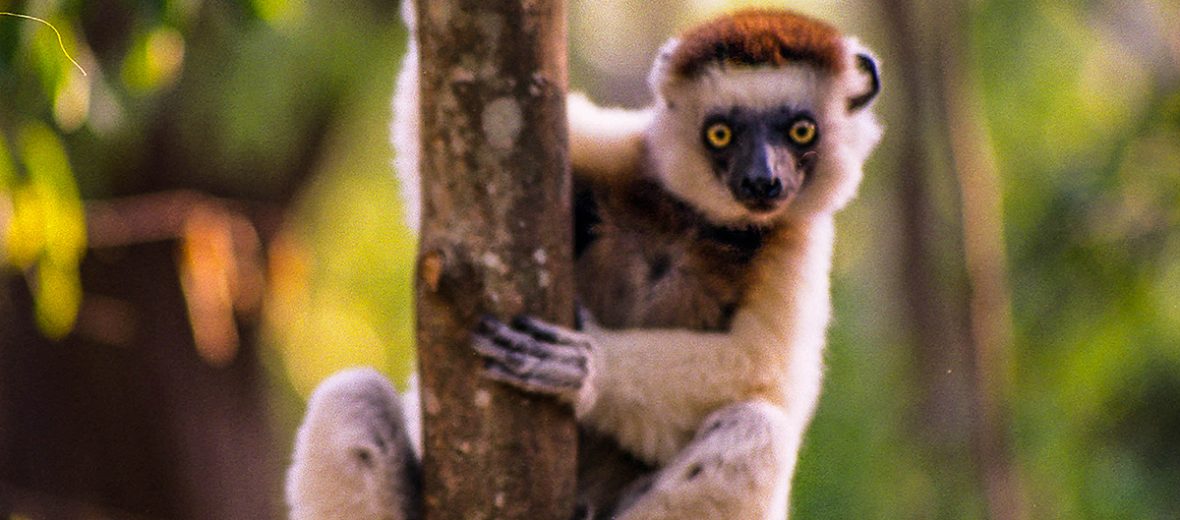
The Verreaux’s sifaka, aka white sifaka, a member of the lemur family (Indriidae) hails only from the island country of Madagascar, from the Tsiribihina River in central western Madagascar south to the Andohahela region. They tolerate montane forests; tropical dry lowland forests; and lowland, humid rainforest habitats. These primates suffer greatly from the threats of habitat destruction and loss at the hands of farming and ranching, logging, mining, quarrying, fires, and fire suppression; hunting; trapping; and invasive species (and with them disease and predation. The IUCN lists these beautiful creatures as Critically Endangered. Their populations are also decreasing.
First the Stats…
Scientific name: Propithecus verreauxi
Weight: Up to 7.9 lbs.
Length: Up to 17.7 inches, plus up to a 24 inch tail
Lifespan: Up to 23 years
Now on to the Facts!
1.) They have evolved to a life in the trees and, as a result, when on the ground, they move about by hopping (with their arms held high).
2.) The Verreaux’s sifakas are the only known sifakas that possess partially webbed feet.
3.) A group of sifakas are called a troop or conspiracy.
4.) Verreaux’s sifakas dwell in a matriarchal society (lead by females).
5.) Troops of up to 13 individuals are formed that consist of up to 7 mature females and up to 3 mature males, plus offspring.
But wait, there’s more on the Verreaux’s sifaka!
6.) These sifakas are diurnal (active during the day), with most activity being in the morning and late afternoon.
7.) They spend most of their time high in the trees at over 42+ feet up.
Did you know…?
These critters earn their namesake due to the shrill ‘shi-fahk’ call they produce.
8.) Bark, flowers, leaves, fruit, and nuts are all on the menu.
9.) Sifakas are polygynous (1 male mates with multiple females).
10.) During the breeding season, the subordinate males will often times challenge the alpha male’s dominance, which ends up in fights.
But wait, there’s still more on the Verreaux’s sifaka!
11.) Mating season lasts from January – March.
12.) Females undergo up to a 141 day gestation (pregnancy) that yields a single infant.
Did you know…?
The Verreaux’s sifaka is a rather picky eater and will only pick the best quality food to eat.
13.) Infants cling to mom’s chest for up to 3 months. Then they begin riding on mom’s back for another 3 months.
14.) At 6 months the infant is fully weaned.
15.) Sadly, these sifakas are often captured as infants and sold as pets. They usually don’t thrive and die a slow, painful death.
But wait, there’s still a little more on the Verreaux’s sifaka!
16.) In a skillful act, these critters will often lean forward towards their food source and gulp it up without ever using their hands.
17.) Deep barks are emitted to call out to each other when they get separated. When an intruder or predator shows themselves, a growling or barking call is produced to alert the others in the troop of danger.
18.) Scent marking is also utilized to denote territory and intent to mate. Only the males possess these scent glands and they are located on their chest.
19.) Fossas, stray dogs, and harrier hawks all prey on these sifakas.
Now a Short Verreaux’s Sifaka Video!
Be sure to share & comment below! Also, check out the Critter Science YouTube channel. Videos added regularly!
Want to suggest a critter for me to write about? Let me know here.
Some source material acquired from: Wikipedia & IUCN
Photo credit: Ron Knight



